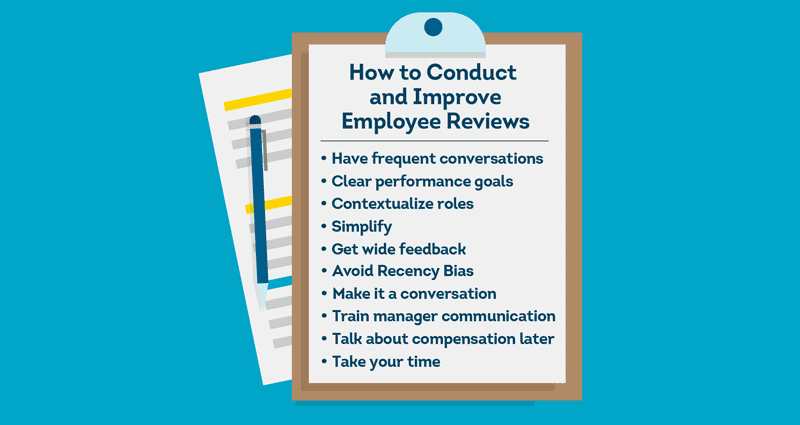Many companies conduct performance reviews, but many workers find them ineffective, unfair, a waste of time, and often demoralizing. To help conduct better performance reviews it’s important to ensure managers are effective coaches, link employee goals to business priorities for context, and differentiate rewards for top performers. Simplifying grading systems and incorporating purposeful, job-specific questions into employee review templates can improve the process, as well.
Disclosure: This content, except as otherwise indicated or stated on this site, is the property of TransUnion Rental Screening Solutions, Inc. This content is for educational purposes and for convenience only. Trademarks used are the property of their respective owners, and no endorsement or affiliation is implied. The information presented in this content is “as is” without warranties of any kind, and specifically is not represented to be complete and does not constitute legal advice, and is subject to change without notice. You are encouraged to check these terms from time to time for changes, and by accessing this site you agree to these terms and all terms listed. Laws and regulations may vary by state and locality. Consult your own counsel if you have legal questions related to your rental property practices and processes.
Disclaimer: Remember that this material is intended to provide you with helpful information and is not to be relied upon to make decisions, nor is this material intended to be or construed as legal advice. You are encouraged to consult your legal counsel for advice on your specific business operations and responsibilities under applicable law. Trademarks used in this material are the property of their respective owners and no affiliation or endorsement is implied.
Conducting employee reviews is like going to a doctor’s appointment. It can be a pain to find time and is sometimes uncomfortable, but also helps catch potential issues while they’re still small enough to cure.
And, just like going to the doctor, employee reviews are an essential task for business health. They can help catch underachieving staff members, build loyalty, uncover and recognize star employees, and help identity inefficiencies. However, for the best results, employee reviews should be conducted strategically.

According to work performance site WorkHuman, about 49% of businesses give annual or bi-annual reviews. But, are they getting the most out of the process If not done well, an employee review process can have a detrimental effect on employee satisfaction and morale.
The most successful recruiting strategies include pre-employment screening through a service like ShareAble for Hires®. Similarly, the best employee reviews include in-depth conversations that go beyond the surface. Without a well thought out plan, you risk disaster before you even start.
However, when it comes to a smooth, efficient process, having a great employee review template is just what the doctor ordered. This article covers how to conduct effective employee reviews, what to include on an employee review template, and much more.
How Employee Reviews Benefit Your Business
These days, many businesses struggle with finding and holding onto top talent. A recent Gallup poll showed that Millennial and Gen-Z employees are also much more likely to job hop than previous generations. This turnover costs the U.S. 30.5 billion dollars annually.
Thankfully, providing a regular feedback is one of the top ways to attract and retain top talent. One part of this ongoing feedback is employee reviews. Regular, ongoing conversations with employees create opportunities for dialogue and growth, give employees a clear path forward, and make employees feel like they’re not forgotten. The end result is that employees who feel seen and valued are more likely to stay.

How to Conduct and Improve Employee Reviews
Unfortunately, though many companies conduct performance reviews, not many get it right. And, in some cases, poorly conducted performance reviews are worse for employee morale and happiness than conducting none at all. According to the Society for Human Resources Management, there are several things you can do to boost your employee review process:
- Have frequent conversations: Avoid limiting reviews to once or twice a year. Address issues as they arise to prevent problems from escalating. Instead, have regular meetings with employees throughout the year.
- Clear performance goals: Set annual performance goals with measurable targets, but be ready to adjust them based on business changes.
- Contextualize roles: Explain how each employee's position and department contribute to the company's overall strategy. This can help employees feel more connected and discover how their job is meaningful.
- Simplify: Keep the review process straightforward without excessive steps, grading systems, or complex questions.
- Get wide feedback: Consider input from colleagues and managers to gain a comprehensive view of employees' contributions, rather than just feedback from one person.
- Avoid Recency Bias: Assess an employee's overall performance during the review period, not just their most recent actions.
- Make it a conversation: Make reviews a dialogue where employees can provide feedback and engage with their managers.
- Train manager communication: Train managers to provide constructive feedback and address subpar performance without confrontation.
- Talk about compensation later: Avoid discussing compensation during reviews. This helps maintain focus on performance feedback.
- Take your time. Compensation and work are important to people. Rushing through or not committing time to reviews can make people feel dissatisfied.
When to Review Employees
Most companies who conduct formal reviews do it once or twice a year. However, these reviews shouldn’t be the only time you talk to employees about their performance. Consider conducting regular check-in meetings with direct reports at least once a month. More meetings may seem time consuming, but this ongoing feedback is especially important when it comes to retaining Millennial and Gen Z employees.
Plus, without regular coaching, it may be difficult to spot the top qualities of the best employees in a once or twice a year review. If you overlook your top performers, they might start looking elsewhere. The last thing you want is to find out your employee was unhappy during an exit interview.
Pro Tip: Employee performance reviews aren’t the only regular check-ups you should be running on your employees. Learn when to run background checks on your existing employees to help keep your business safe.
Employee Review Template: What to Include
What’s clear is that many companies conduct reviews, but may not be maximizing their potential effect. According to a survey by research giant McKinsey, 54% of surveyed workers thought performance reviews had no positive effect on performance, and many see it as a waste of time.
A big driver in that perception is that many employees don’t believe the typical review process is fair. They also believe the process is often over-complicated and requires too much work.
After analyzing the data, McKinsey stated that the three biggest changes you can make to increase the “perceived fairness” of reviews are:
- 1: Effective coaching. Make sure managers are effective coaches and have an existing, ongoing relationship with employees before conducting reviews. If your managers are not good at coaching conversations (or don’t know the employee well), you may need to make a change.
- 2: Contextualize. Link the employee’s goals to the business priorities, so the employee knows where they fit in, the value they provide, and the path forward.
- 3: Reward top performers. Differentiate compensation among low, medium, and high-level performers––just make sure to keep the compensation conversation separate from the formal review.
According to McKinsey, making these adjustments to your existing process can help make it better. With that in mind, here are some ideas of what to include on your employee review template.
What to Include on Your Employee Review Template
Like the SHRM and McKinsey studies mentioned above, research from the Harvard Business Review also explains that to be effective, employee review should be a conversation, not just a graded score that’s never mentioned again.
In general, make sure your employee review template is:
- Customized for the job
- About job performance, not the person
- Includes specific information and timeline on how follow-up will be managed
- Allows for a two-way conversation
- Is clear about the ethical standards about how the employee will be judged
The studies mentioned also advise companies to leave out the following from employee reviews:
- Conversations about compensation.
- Instead, keep it focused on performance.
- Overly complicated rating systems or instructions.
- Instead, keep it simple and easy for both sides to complete.
- Vague, or non-specific feedback such as “You need to work on your communication skills” or “You lack experience in certain areas”
- Instead, be specific and provide examples, such as “You need to reply to emails more professionally”
- Review a surprise or add in unexpected questions or assessments
- Instead, provide materials and questions well-ahead of time, so employees have time to prepare and feel more relaxed.
Example Sections for an Employee Review Template
To help you create your own, here are the sections on a typical employee review template. Note that these are only for reference. It’s essential to customize your employee review template to your company and the specific worker’s job:
1: Company and Employee Information
Make sure to include employee and company information on the review, including:
- Company name, contact information, and more
- Name and title of employee
- Name and title of reviewer(s)
- Date of review
- Period of review (e.g. annual review, semi-annual review)
- Anyone else involved in the process
2: Transparent Grading System
Many employee review templates have a grading system, which asks employees to rank their own performance from 1-5. If you use a similar system, it’s best to keep it relatively simple and not require complex calculations or overly-long written responses.
For example, these ranks could correspond to:
- 5: Extraordinary: Always far exceeds standards, exemplary employee. Exceptional mastery of all job tasks. Shows constant creativity, innovation, and professionalism. Excellent contributions to the business.
- 4: Great: Achieves well beyond normal expectations. Exceeds all goals and targets beyond expected standards.
- 3: Satisfactory: Meets all goals and targets, as expected. Meets deadlines and completes tasks.
- 2: Unsatisfactory: Failure to meet standards and quality of work below expectations. Failed to meet goals.
- 1: Poor: Consistently substandard work. Rarely meets expectations. Requires significant improvement.
Whether you’re asking employees to rank themselves with numbers or just have a conversation, it’s best to provide employees with questions ahead of time, so that both of you have time to prepare.
Additionally, it’s important to reflect on the entire review period when grading, not just the most recent work (Recency Bias). For example, if an employee is usually great, but has had a tough few months due to some unforeseen circumstance, make sure to judge their performance on the entire year, not just the last few months.
3: Sample Employee Review Questions
The next section of an employee review template often includes a set of questions. Employers typically rank their own performance and write an explanation of their response. Separately, managers rank employees and explain the basis for their responses, as well.
This assessment is typically completed ahead of time. Then, during the actual review, employers and managers compare and discuss their answers. The following are some examples of typical questions found on employee review templates:
Sample Questions (Rank performance on a scale of 1-5):
- Reflect on past success: How successful have you been in the past year What were your major accomplishments and contributions over the past year (or review period)
- Consider areas for improvement: How much have you improved in the past yearAre there any specific areas where you feel you need additional training or support to improve your performance
- Reflect on their place on the team: How well do you work in a team, and can you provide an example of a recent collaborative project
- Contextualize their role in the company’s mission: Can you describe how you've demonstrated the company's core values and contributed to our culture in the past year
- Discuss future goals: What are your career goals, and how can the company help you achieve them Try to use SMART goals:
- Specific
- Measurable
- Achievable
- Realistic
- Timely
Remember that according to the McKinsey study, SHRM research, Harvard Business Review, and others, one of the top complaints from employee reviews is that the process is too complicated and the ratings aren’t perceived as very fair and meaningful. Make sure any questions you ask have a distinct purpose and that they’re customized to the job and company.

4: Finish and Follow Up
Once the review is over, make sure to:
- Add any comments or follow-ups to the actual review, such as expected next steps
- Add any follow-up dates, such as the next review or meeting
- Have both employee and reviewer sign and date
Pro Tip: Once the employee’s review is complete, make sure to store it in the correct employee file.







